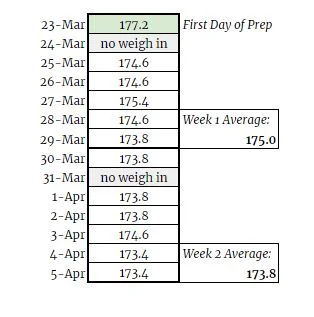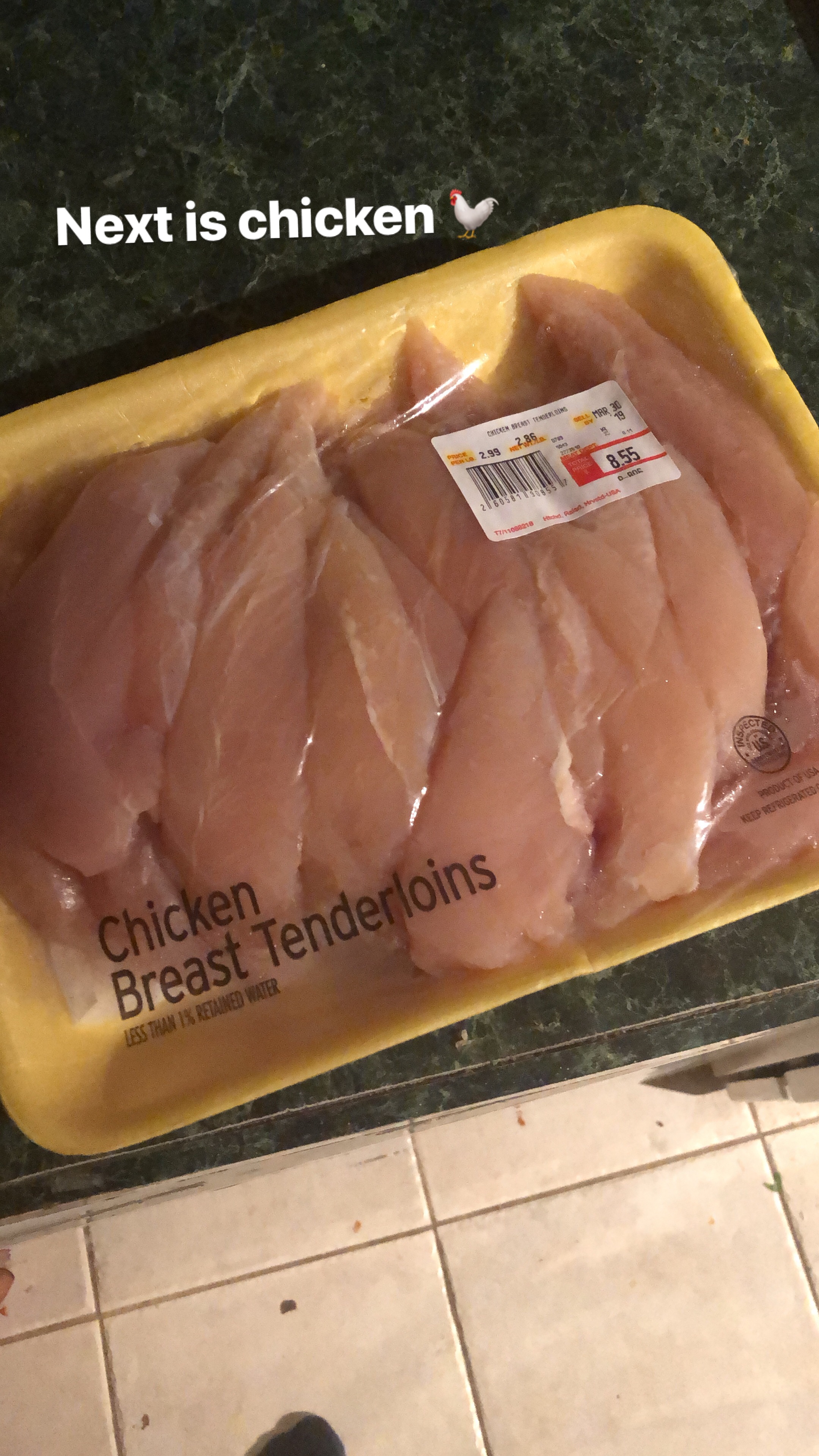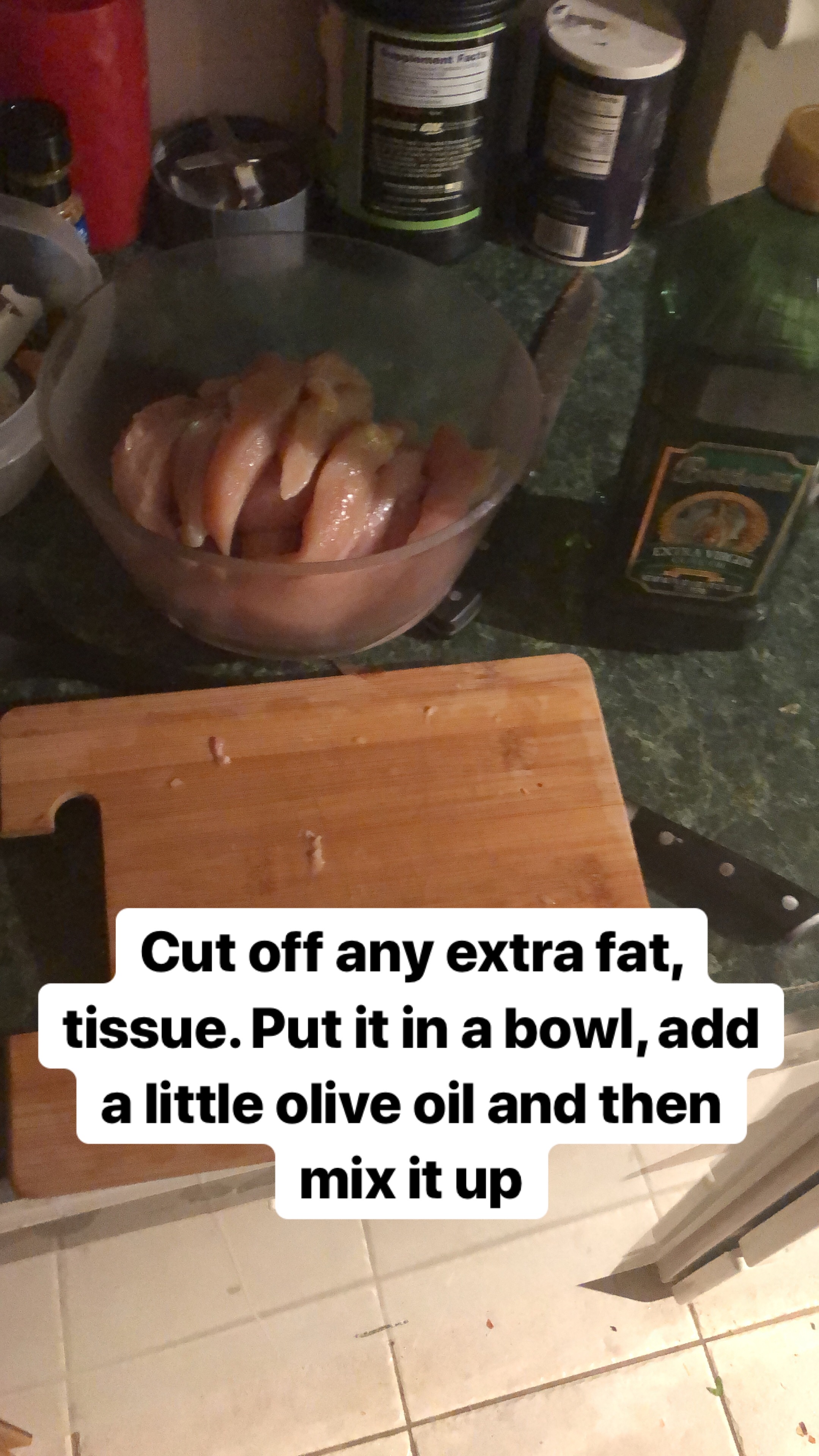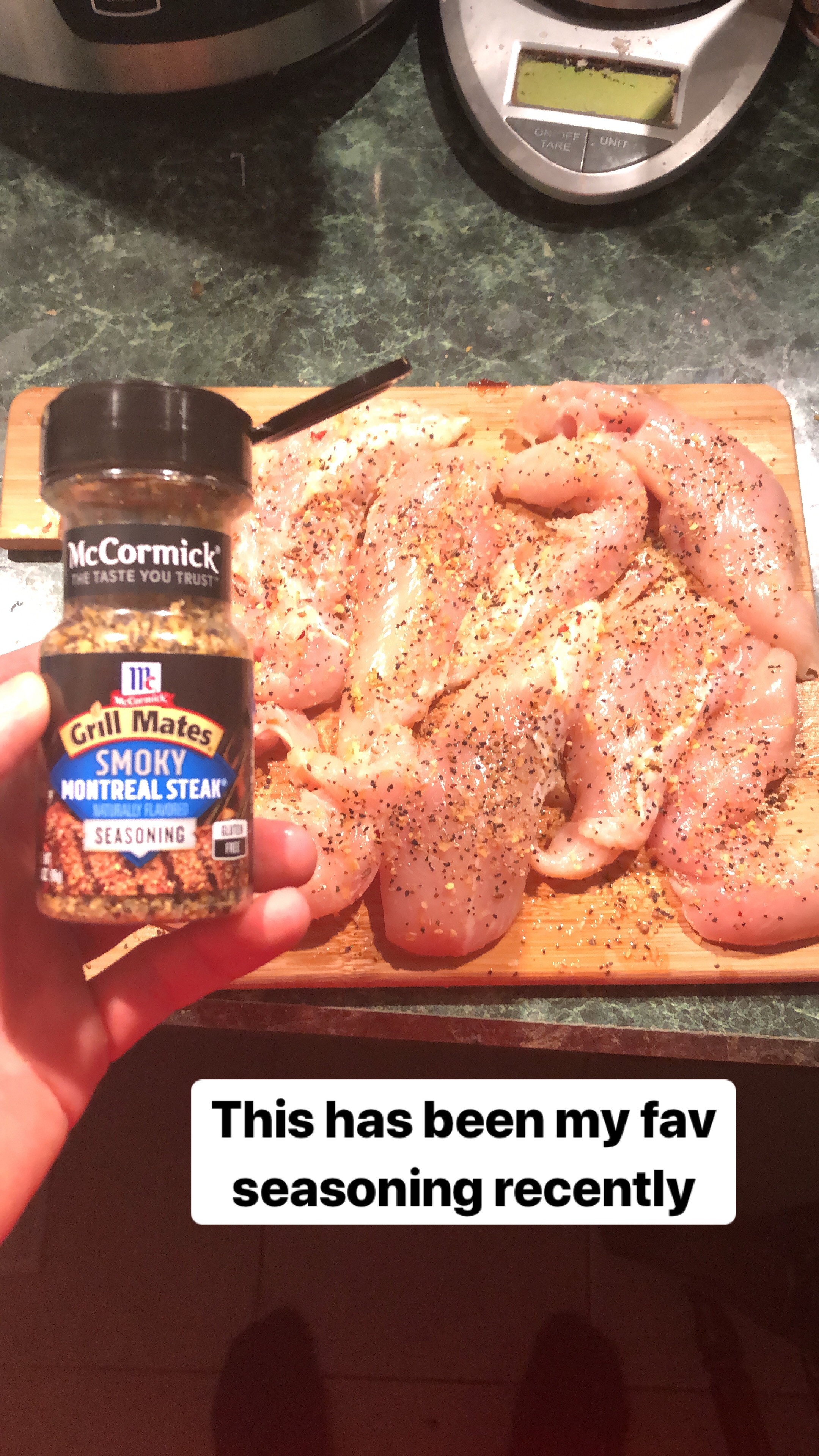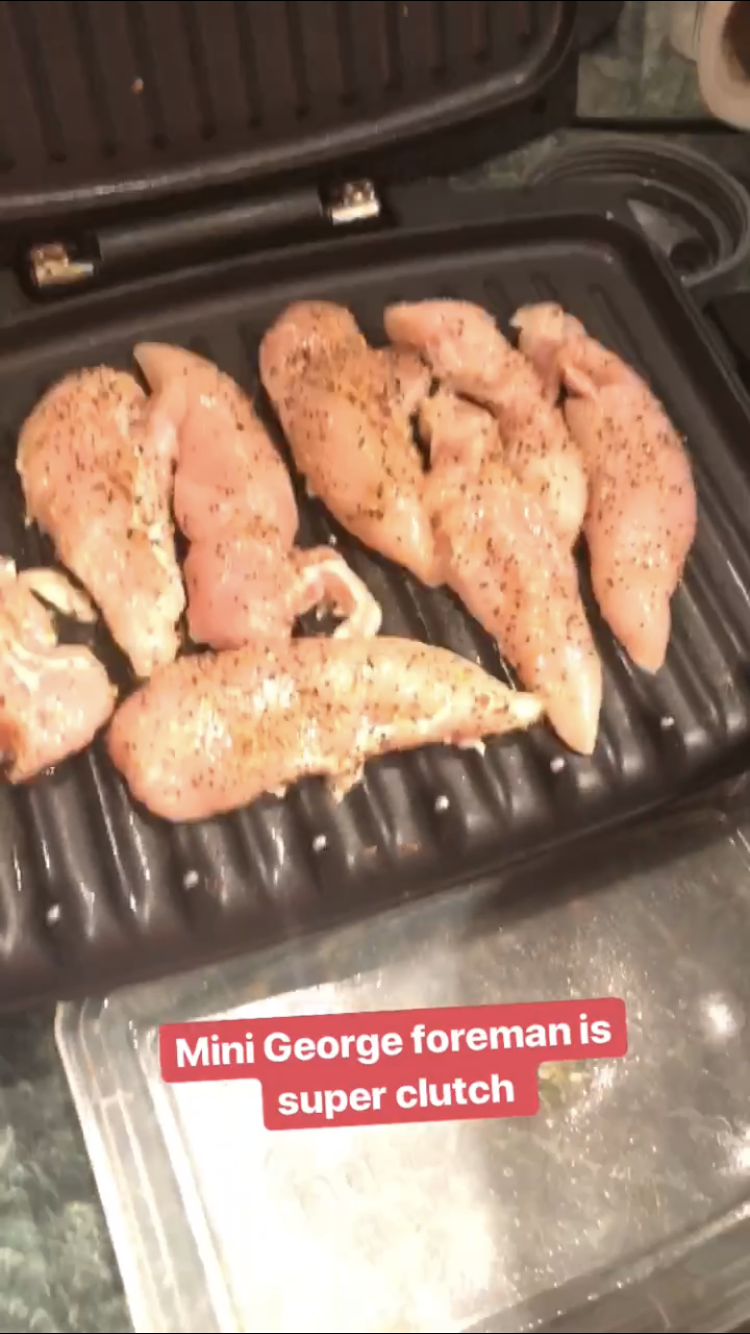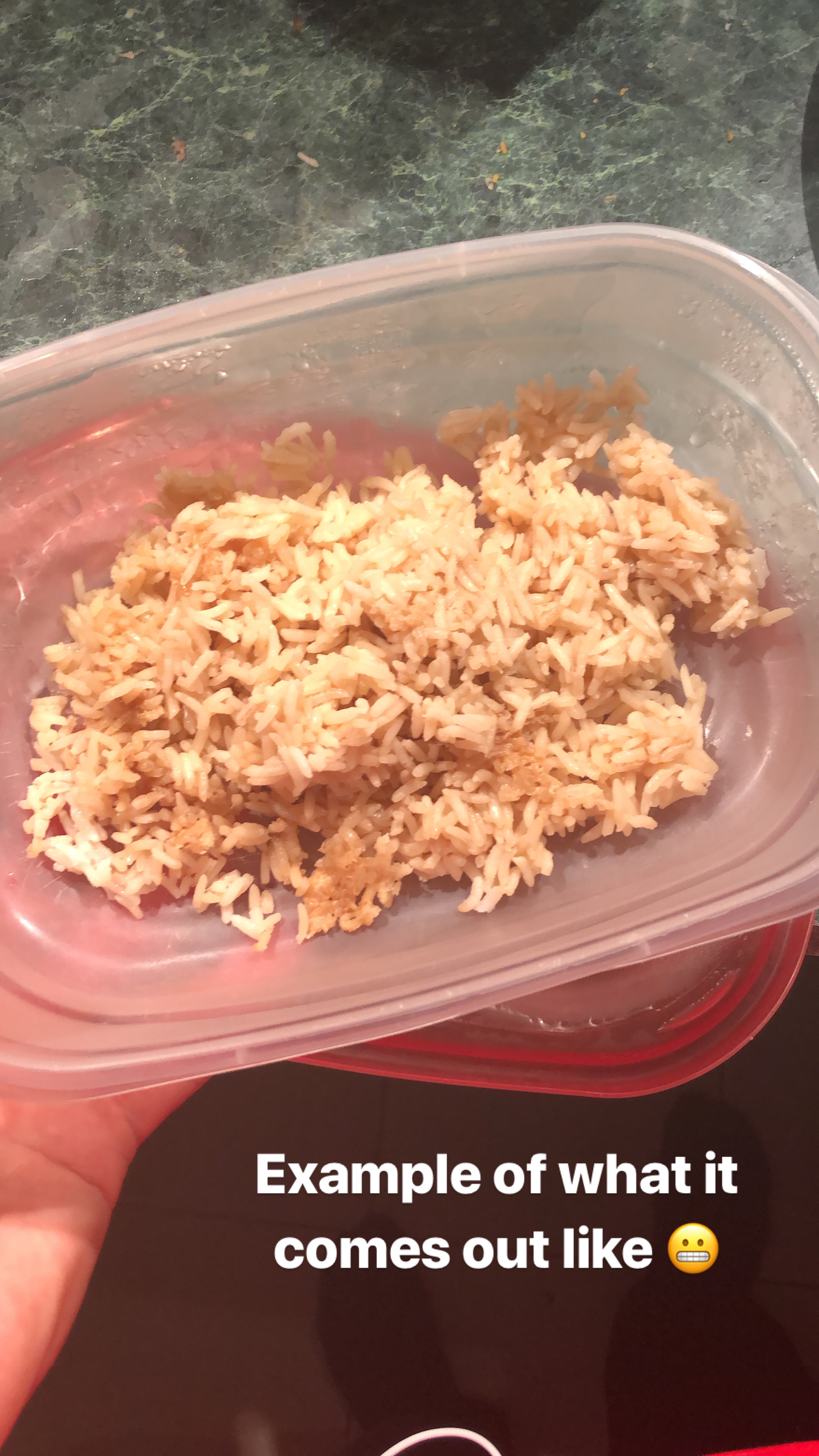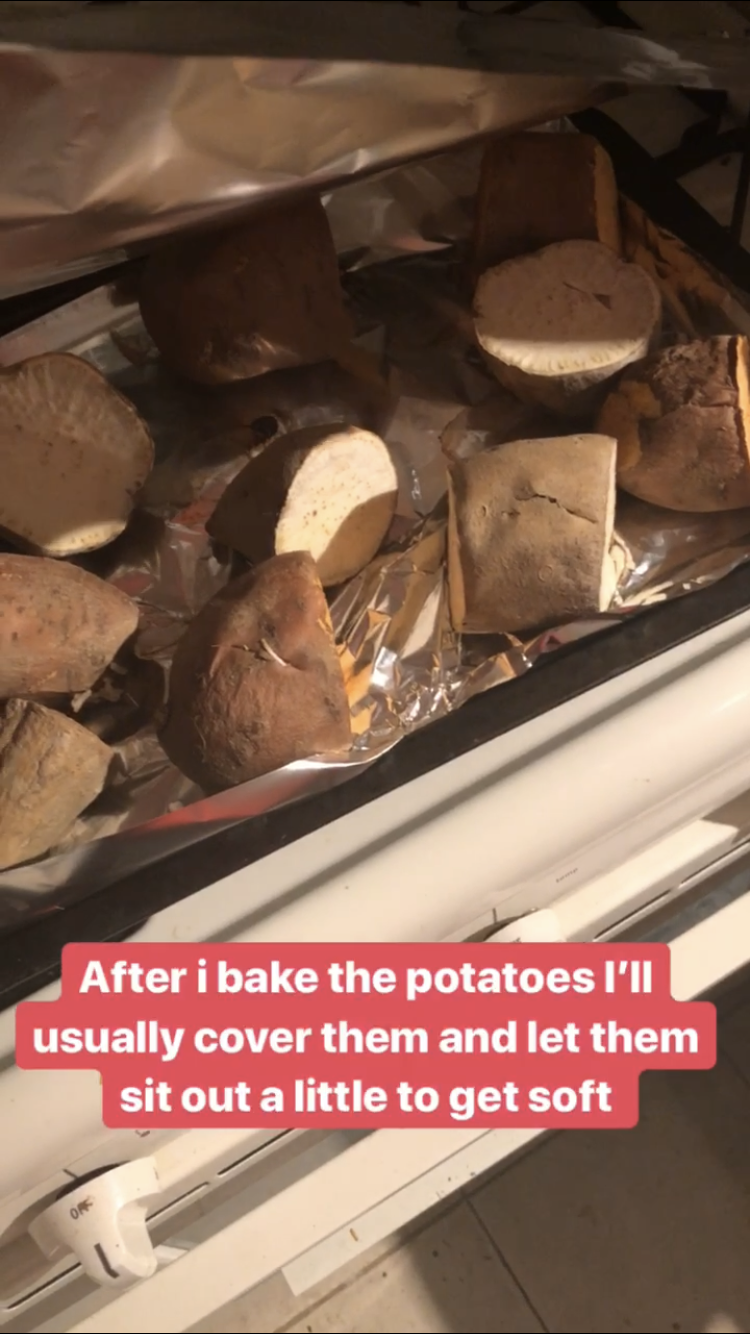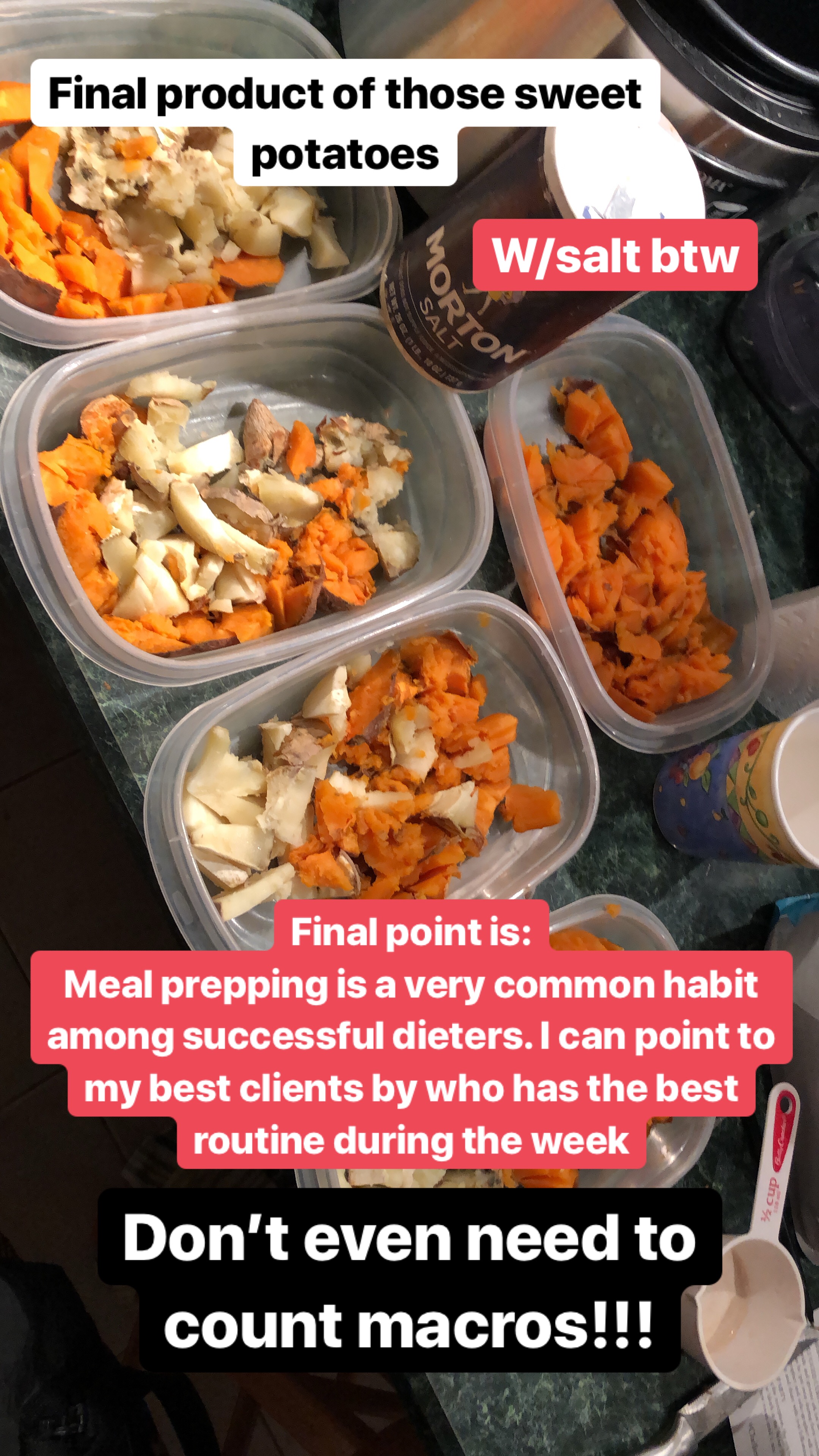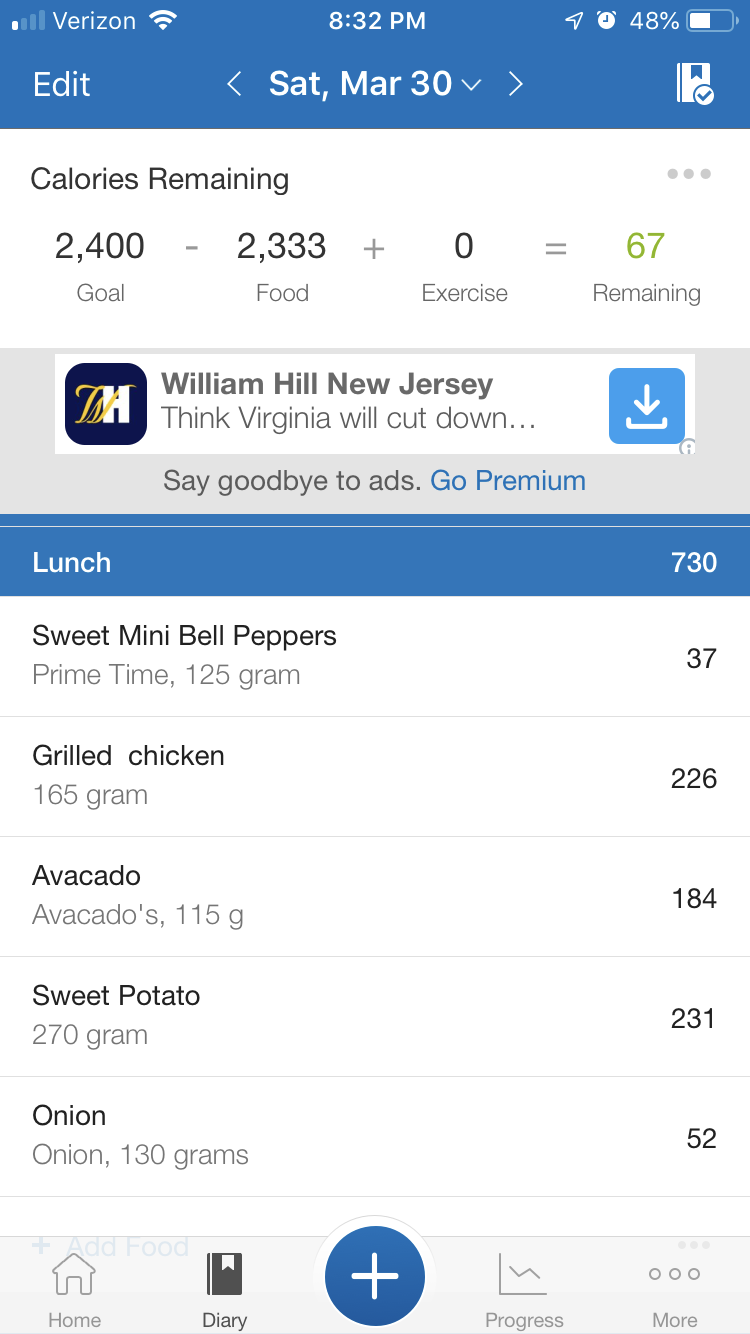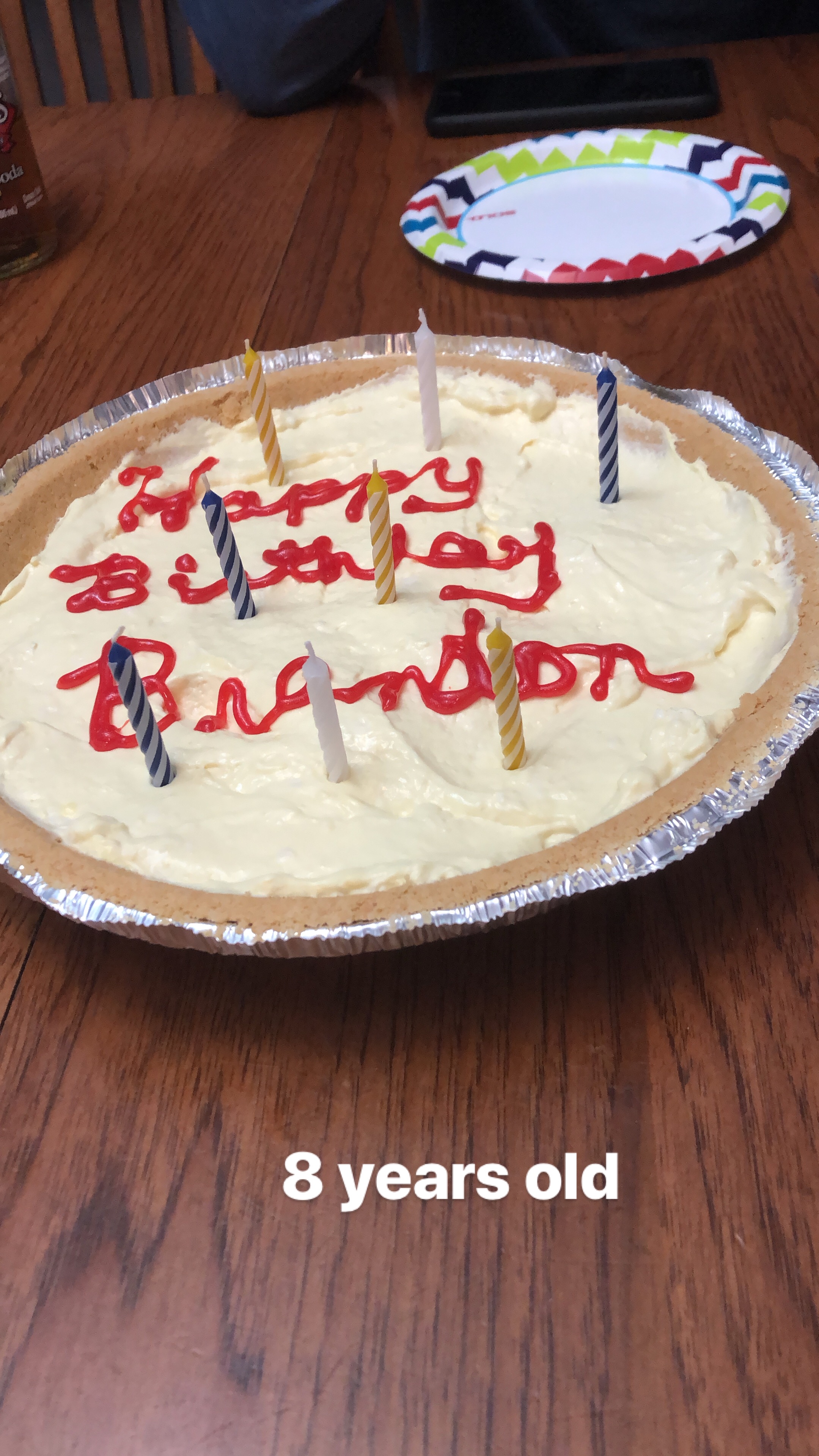Brandon's Contest Prep: Week 2
This is the second official entry for my “Contest Prep Diary” for 2019. Click Below to read week 1:
recap
Week 2 of my contest prep! So what has exactly changed from week one?
Contest Prep is such a hardcore, extreme process so that must mean there have been RADICAL changes since week 1 right?
New Macros?
Have I had to manipulate training?
Carb cycling?
New foods?
Not quite.
The reason I wanted to make that hyperbole is to address a common theme that will illuminate itself as the weeks go on. CHANGES are only made when you have a large enough sample size and enough accurate data that is telling you of WHAT is going on. As coach Steve likes to put it:
“Random changes yields Random results”
So first, let’s look at how one variable that we are measuring has changed thus far.
Scale Weight changes:
The scale is a common assessment tool for physique competitors that has its benefits as well as pitfalls.
Scale Weight from Weeks 1 and 2
Let’s look at some data.
Common reactions:
”Wow, 2.2 lbs in the first week? Didn’t you say you were only shooting for a pound a week? Are you going too fast? Shouldn’t you increase calories by 500 so the deficit is less?”
“From the last day of Week 1 to the last day of week 2, you only went from 173.8 to 173.4, is your fat loss stalling?”
Let’s look at some Realities and Facts:
Macro Comparison from Maintenance to Weeks 1 & 2 of the Cutting Phase.
Starting Point: When I did a maintenance phase before my cut, my average body weight was 176-177 for 5 weeks at maintenance macros.
5 weeks is a GREAT data set to be sure that was a good starting point. (More on maintenance phases HERE)
Carbohydrate Reduction: From maintenance to my cutting macros, CARBS and overall CALORIES were reduced. Carbohydrates can be stored in muscle glycogen which, attracts water along with it.
This is why when eating more food or carbohydrates in general, you will hear bodybuilders coin the term “fuller”. This is because there is more acute storage of carbohydrates and thus water in your muscles that gives you the appearance of being bigger.
Water Loss from Carbs: When cutting, and ESPECIALLY if you are doing Keto (read THIS to see why), you will see a scale weight drop from carbohydrate intake drop. Therefore, the first week of data should more or less be IGNORED on most occasions.
That is, if you have a very good understanding of your maintenance and overall cutting macros, which me and my coach have nearly 2 years of data worth :)
(More on Carbohydrates and other macros HERE )
“So what gives on week 2?”
“If macros stayed the same, then isn’t this a sign that your macros were not low enough? Because now the water weight loss is controlled.”
Averages over time: It is important to look at AVERAGE weigh-ins over individual weigh-ins. From week 1 to week 2, there was a ~1.2 lb scale weight drop (175.0-173.8 lbs).
But that’s not 1 lb, should you make an adjustment? Nope. This is good enough. Scale weight can differ on so many factors and in this scenario, THAT is enough to signal that we are still on track.
Overthinking on a diet is going to hurt you most of the time. Right now is the time to relax and trust the process.
Physique Update:
What about a physique update? Won’t this confirm that if you see some drastic changes that you actually did lose fat?
For now, it is NOT useful to take physique assessments as frequent as week to week.
Remember that fat loss happens ALL over the body, so there won’t be anything TOO telling from week 1 to week 2 that can actually give you the story of what is really going on.
Nutrition
Macro Changes: Macros did not change from week 1 to week 2.
In fact, in the 14 total weeks of cutting that I have undergone thus far, there has only been ONE change in macros/calories (excluding going on diet breaks). Essentially, “if it's not broke, don’t fix it.”
Therefore, I figured with this entry that I would go into a little more detail as to the preparation of the food that entails these macros!
MY MEAL PREP
Because I work a day job which I’m at for 40 hours during the week, I don’t have the luxury of being able to cook and prepare all my meals right before I eat them.
Taken from an old IG story
Therefore, I meal prep to keep me on track. When juggling, a full-time job (40 hours a week), training & cardio (10-13 hours/week), side job (~15-20 hours/week), and quality sleep (at least 8 hours a night) you don’t have a lot of time to waste.
Meal Prep helps simplify the time crutch and keeps me in check through:
More Efficiency: Instead of preparing the same meal every day, I prepare it ONCE on Sunday to conserve cooking time during the week.
Less Decision Fatigue: an often forgot about stress is that of making decisions.
Having similar meals or meal templates day to day, week to week helps eliminate decisions and therefore, stress/energy (which is a already in limbo because of cutting).
This allows me to use more stress/energy to make more important decisions such as how I am going to get around pressing roadblocks/deadlines at my full time job during the day.
Consistency of Macros: Meal prepping is a sure fire way to make sure you stress less about your macros and your hunger.
If you plan out when and how much food is coming in throughout the week, it gives your body that comfort signal that it does not have to be as stressed. You can split up your meals in such a way so that you aren’t left with no macros at night before you go to bed. The last thing you want is to “go to sleep for dinner”
Less Spontaneous Meals: A lot of times when dieting, “situational” cravings and hunger will kick in.
If you are in a setting surrounded by people who are perhaps encouraging some other type of eating, there’s a chance you will cave in.
By meal prepping, it makes sure I’ve at least prepared every breakfast and lunch to make a conscious choice to only eat those foods and not give in to other situations that may arise that will throw me off my routine.
examples
Here are some pictures taken from my IG story (@brandonjod) about how I meal prep to set me up for success during the work week!
To summarize:
SPs: cut them up and put them in the oven for 45-55 minutes. Portion them out for BF each day. I usually make the egg whites that go with it the morning of as I wake up to go to the gym
Chicken: Portable george foreman's are a great investment to grill a lot of chicken at once. I’ve had mine for 2 years now and have had zero problems while using it nearly every week.
Seasonings: I salt most of my meals when cutting for extra sodium. Otherwise, mix up your seasonings to get some extra variety on your meats while dieting. Cinnamon even works well for Sweet Potatoes.
Rice cookers: a lot of rice cookers can also be used as a mini crock pot if you like using that. I like including rice in my diet no matter the phase I am in, so therefore being able to just click a button to get a lot of rice into my diet is pretty useful.
training
A very common question and concept to explore is “how to progress training week to week” and additionally, “how to progress training on a cut?”
how realistic?
While we want to actively seek out progression week to week, we must understand that it is NOT always attainable while cutting.
In my experiences, I have found that in the beginning stages of a diet, you can maintain or slightly progress some leg movements as well as back movements. Pressing movements for me, seem to be the first to go in terms of progression or maintenance. Isolation exercises can be maintained a little, but you will start to see bigger drop off sets to set when the going gets tough.
Some Training Progression Examples
Have a Good starting Point: It is important to know the Minimum “Dosage” of Workload to do in order to make progress when starting a training block. You want to have a balance of starting off easy enough so that you actually can PROGRESS in the future, but not SO easy such that the training is not above a “Minimum Effective” Level (commonlly coined MEV).
Strategically Progress Volume: But when we can, we must at least have avenues to progress, even slightly throughout the training block. Since accumulation of quality volume over time appears to illicit the greatest hypertrophic response, progression through volume increases is what I will actively seek out week to week.
Here are some practical examples of how this can be done:
Intensity: On a movement where you do a lower rep range and have a decent amount of weight on the bar, it can be practical to add weight on the bar each week while trying to match reps.
The other variable will change is how much “effort” you put forth on each set. This is commonly termed “RPE” or “RIR” (Rate of perceived exertion/Reps in Reserve). When going up from 200 lbs to 205 lbs on a 6-8 rep max you are going up 2.5% (5/200) in intensity. Therefore, its a more practical avenue to add weight while trying to match sets. With that, you will also naturally go closer to technical “Failure” of the movement.
Reps: a 5 lb increase on a 6-8 rep max is MUCH different for a 5 lb increase on a 10-12 max. Even if it is for the same amount of total weight. Therefore, in some instances it makes sense to keep your intensity static (weight on the bar) week to week, and just aim to get to the top end of your rep range. Again, your proximity to failure will get closer and closer as you try to add more reps week to week.
Sets: Movements that hit smaller muscle groups at the tail end of your workout are not as practical to make intensity jumps week to week. A 5 lb increase on a 300 lb deadlift is only 1.67% increase while a 5 lb increase on a 50 lb Machine Lateral raise is a 10% increase from the previous. Therefore, it one avenue to progress is to add another set. While either matching previous rep targets or increasing them. By getting more total reps, you are still adding more volume.
In short, there are a multitude of ways to progress your training. These are just 3 that I use the most often. In future weeks, I can go into MORE ways to progress your training, but for now I want to keep it simple :)
events
Although I’m a die hard Yankees fan, it was awesome to see Bryce Harper in person in Philadelphia
A quote I like to tell myself and my clients is something like:
“The best dieters are those who excel when IN and OUT of their routine”
A routine like meal prepping can set you up for dieting success during the week. But chances are, you won’t be meal prepping EVERY day.
To start off the second week of the diet, I traveled back home to South Jersey to go see Bryce Harper play (and hit his first homerun) for the Phillies in Philadelphia on Saturday. Later that night, my family and I had a delayed birthday🍰 celebration for me because it was the first time I had seen them since my birthday on March 15th.
Sounds hectic, what did I do to manage all this?
my gameplan
What Doesn’t work for me:
My Lunch I ate right before going to in to Philly.
In MY experiences, extreme calorie cutting or fasting during the day or the days leading up to an event makes me much more hungrier.
Not to mention, it magnifies the event itself as this glorified special time to eat a plethora of food and I will end up looking forward to it.
To me, that ends up psychologically dampening the rest of the day/week and then putting unrealistic expectations onto how much one meal or event can potentially make the suffering worth it.
What Does work:
I like for the day to be as normal as possible in order to stay on track.
Therefore, I ate relatively normal up before the game. But, I maneuvered around some of my food so that right before I left to go to Philadelphia I had a larger meal.
I added:
a little bit more vegetables than usual
a fibrous carbohydrate in the form of sweet potato
protein (of course)
avocado for some fats to help slow the release of the food into my digestive track so I would feel full for longer
Then, as I tell my clients for any event, enjoy the EVENT itself and NOT the food that comes with it.
If you are too focused on the food and drink, it will take away from the real reason you are there which is to enjoy time with friends and family as well as the game in this case.
birthday compromise
Lastly, ever year for my birthday my mom likes to do a birthday cake to celebrate. I enjoyed a LOT of good food in the earlier stages of my diet (I was cutting at and around Thanksgiving, Christmas, New Years and other mini vacations) where I was flexible.
For this instance, I negotiated with my mom so that we could make a low calorie cheesecake for us to enjoy, but also where I could still stay on track. It's important to remember that you won’t always be in control of your situations, but if you can make some compromises those are the little victories that can help you find balance in these events.
That’s why It's also a good reason to practice managing these events in your offseason where you have more room for flexibility as well as some experimentation with what works best for YOU.
(More on how to manage your environment while dieting here )
CONCLUSION
Thanks for Reading!!
Slowly, but steadily making more progress and excited to see how my body reacts.
Next week I will be talking about:
When you will have a low or high weigh-in
Fatigue management through exercise selection
Caffeine intake
Any further questions, ask me on Instagram: @brandonjod
